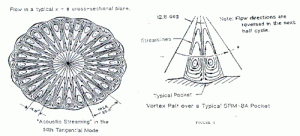After the Challenger disaster, STi’s personnel were specifically called in by Morton Thiokol to determine all possible reason of failure of the Solid Rocket Motor (SRM). After STi analysts examined the (SRM) design, they presented their findings in a detailed report. This effort continued during the redesign effort of the “Redesign of the Solid Rocket Motor” (RSRM). Some excerpts of the anomalies found in the independent audit process are presented below:
Evaluation of the following fracture criteria for suitability to SRM composite nozzle material:
Limited Criteria: Operational simplicity, onset of failure and failure mode is predicated, failure occurs when a stress or strain parameter reached its limit. Max strain theory.
Interaction Criteria: Curve-fitting technique that lack a sound theoretical basis-to be avoided.
Tensor Polynomial Criteria: Onset of failure is predicated, unequal tensile and compressive strengths. Biaxial tests are required to e evaluate interaction terms.
Direct Laminate Criteria: Mode of failure is not predicted, lacks generality of laminate strength; laminate criteria can be used to verify failure envelops on a ply-by-ply basis.
Progressive failure modes in Carbon/Epoxy laminates under biaxial stress conditions (Elasto-plastic fracture).
Include the interaction of mixed mode loading on cyclic debonding of adhesively bonded composite joints (delamination growth).
Temperature 1 inch ahead of O-ring may be greater than 1900o F (Melting temperature of D6AC Steel = 2150o F).
O-ring ejection due to excessive nozzle joint rotation.
Liquid alumina jet arc impingement erosion of insulation ahead of O-ring (similarity analysis w/Titan problem) at 1900o F and approximately 968 PSI Aft dome pressure.
Circumferential flow patterns in the Aft dome/fixed housing region result in pressure/velocity of gas glow gradients ideal for liquid alumina stability (91 Meters per second).
Prediction of pressurization and erosion of the O-ring during motor ignition – design simulation assumes 10 mils/1000 PSI of joint rotation rate instead of ANYS predicted expansion rate.
Nozzle-Case joints are assembled horizontally without shims. The weight of the case is sufficiently large to cause out of roundness during assembly. Only a few Mils of eccentricity can cause a doubling of erosion depth if the narrow-gap aligns with blow-hole and if the growth rate of the jet height is less than one third of that of the overall joint gap.
A single seal on the leak check port lugs may result in a single point failure.
Axial solenoidal vortex motions such as transverse “acoustic streaming”

Axial solenoidal vortex motions such as transverse “acoustic streaming” can exist naturally in the contraction region of the SRM nozzle. (A presentation of wave motion in the spinning mode giving rise to 14 circumferntial antinodes and wave motion in the standing mode giving rise to 28 antinodes of tangential velocity is shown in Figure 1). This region causes a mean combustion gas flow acceleration from a mach number of approximately 0.1 where the flow attaches to the nose inlet to mach 1.0 at the throat. There is an attendant drop in static pressure, temperature and the speed of sound as the flow accelerates at the throat/nose inlet rings. This area is considered to be a resonance length section where disturbances at particular discrete frequencies can be amplified.
